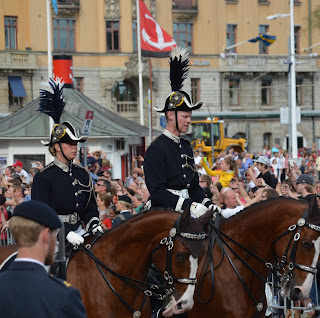Russia would have felt more ominous if it had been a cold, grey day. On a sunny day, St. Petersburg felt, in Gabby's words, like another old European city. Five million people live within 18 city districts spread over 44 islands that make up St. Petersburg, the second largest city in Russia.
Thanks to our super organized friend/personal cruise director, Sophie Fang, we took a St. Peters ship organized tour of St. Petersburg to see the highlights of the city and a tour of the Hermitage Museum. The benefit of a ship organized tour is swift disembarking before the general crowd. Following are the highlights and history bits from our guide...
A very brief history lesson -
1700 - 21 year war against the Swedes for access to the Gulf of Finland
1703 - Romanov Tsar Peter the Great founds St. Petersburg
1713-1728 - St. Petersburg, capital of Russia
1732-1918 - St. Petersburg, capital of Russia
Late 1700 - early 1800 - built the St. Petersburg sea port
Up to the mid 18th century - architecture is Russian Baroque followed by Neo-Classical
1914 - renamed Petrograd
1917 - end of the Romanov era with the Lenin revolution, moved the first Socialist government back to Moscow
1924 - Lenin dies, St. Petersburg renamed Leningrad until 1991when the original name is reinstated
The first stop on our tour...
 |
| Rostra - red columns - decorated with parts of defeated boats, former lighthouse |
 |
| Grandma Lorene |
 |
| waiting for a photo op |
 |
| stock exchange, across from the red columns |
The Church of the Savior on Spilled Blood was built (1883-1907) at the site of Tsar Alexander's 1881 assassination. Soviet rulers wanted to destroy the church, however war distracted them thus saving the church, although it was badly damaged during the Russian Revolution in 1917, used as a temporary morgue during WWII, and post WWII used as a warehouse. The church was fully restored from 1970-1997. The interior of the church is covered with over 7500 square meters of
mosaics. Unfortunately our tour did not include time to see the
interior, something I definitely would love to return to see.
 |
| battle scars on the church |
 |
| ornate gates surrounding the Church |
The Hermitage Museum is one of the oldest, largest museums in the world, founded by Catherine the Great in 1764. It occupies six large buildings, the main one being the Winter Palace, the former Russian emperors' residence. The Hermitage is closed on Mondays and free the first Thursday of every month. There is no way to show even a fraction of the Hermitage's over 3 million items and the largest collection of paintings in the world, I think the interiors themselves are equally stunning....
 |
| the Winter Palace - now the Hermitage Museum |
 |
| enough gold to make Donald Trump proud! |
 |
| beautiful inlaid wood floors |
 |
| beautiful mosaic floors |
 |
| Pavilion Hall |
 |
| Pavilion Hall |
 |
| Italian Renaissance galleries |
 |
| monkeys outside the Winter Palace... their owner wasn't happy we were taking their pictures |
Palace Square - setting for Bloody Sunday (1905
- unarmed demonstrators were shot by Imperial Guard as they approached the Winter Palace to present a petition to Tsar Nicholas of Russia)
and the October Revolution of 1917. The Alexander Column (center, 1830-34) made of red granite (tallest of its kind in the world) is 47.5 meters high. On a happier note the Palace Square has hosted concerts by the Rolling Stones, Elton John, Madonna, and Sting... just to name a few.
 |
| Winter Palace/Hermitage Museum on one side of Palace Square |
 |
| Palace Square - Alexander Column - not to be confused with the Red Square in Moscow |
 |
| Guard Corps Headquarters (1837-43) |
 |
| General Staff arch |
Walking around St. Petersburg in search of Starbucks...
 |
| wedding limo |
A trip is not complete without a visit to Starbucks to buy a mug and
get some free WiFi. Our names were written in Russian on our drinks...
we're easily entertained.
 |
| Starbucks Coffee - not easy to spot the name... luckily we spotted the logo |
 |
| sometimes it's nice to know exactly what you're getting, a little slice of Americana! |
 |
| Gabby |
St. Isaac's Cathedral, dedicated to St. Isaac of Dalmatia, a patron saint of Peter the Great, largest Russian Orthodox cathedral in the city, fourth largest cathedral in the world, constructed from 1818-1858. Under communism the church was stripped of religious symbols and in 1931 turned into a Museum of the History of Religion and Atheism, now simply the Museum of the History of Religion. During WWII the dome was painted grey to avoid attracting enemy attention. The church remains a museum although a side chapel again holds services. Again, we only saw the exterior, something else to see on the next trip!
 |
| the dome is 101.5 meters high and covered in pure gold |
Monument to Nicholas I of Russia, 1859. Unusual at the time because the horse was only supported at two points.
 |
| proof that we were there |
 |
| old Russian symbol - double headed eagle |
 |
| welcoming band at port |
 |
| Communist era port building |
Random photos of St. Petersburg from the bus...
 |
| Peter and Paul Cathedral inside the Peter and Paul Fortress |
 |
| the Bronze Horseman, monument to Peter the Great |


























































































